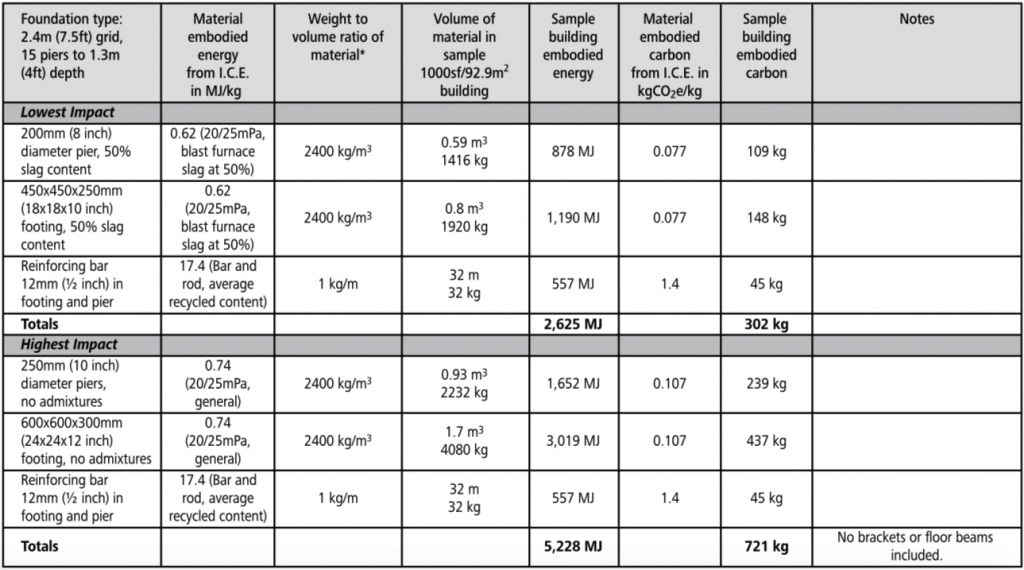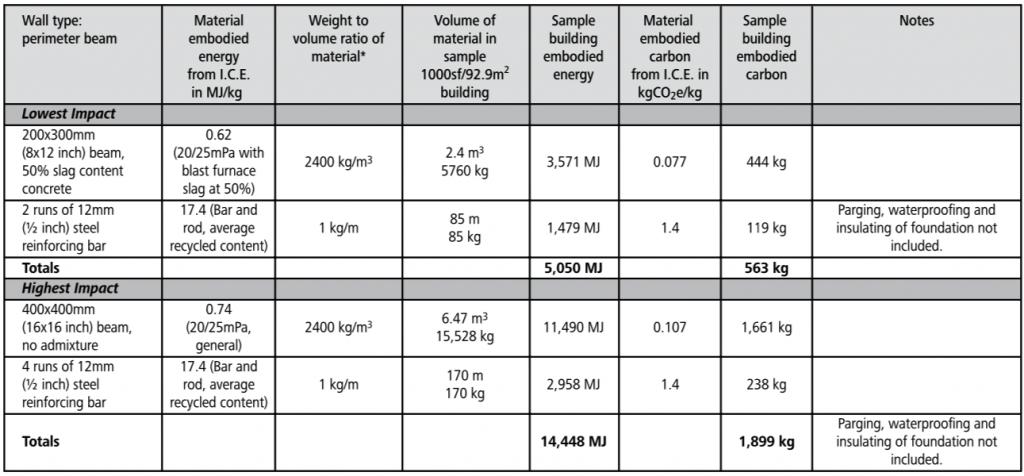Poured concrete
FOUNDATIONS: MATERIALS ENCYcLOPEDIA
Applications for this system
Perimeter Beams
Piers
Frost walls (not covered due to high environmental impact)
Basement walls (not covered due to high environmental impact)
Slabs (not covered due to high environmental impact)
Basic materials
Portland cement
Other binders to offset portland cement use (can include fly ash, blast furnace slag and other pozzolans)
Aggregate
Water
Steel reinforcing (rebar and/or mesh)
Ratings Chart for concrete pier Foundation
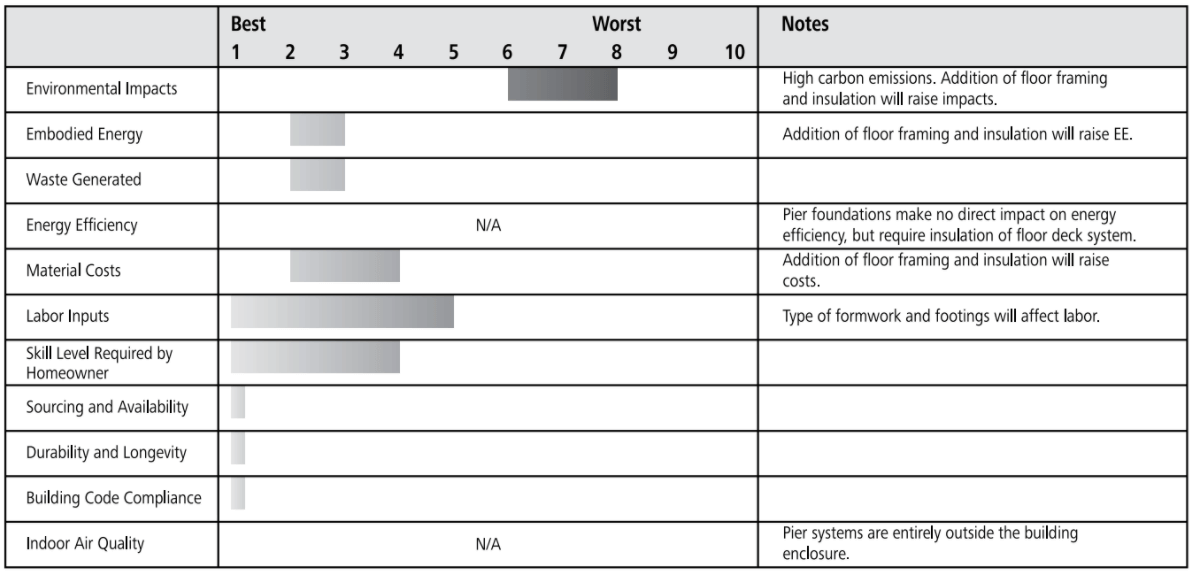
Ratings Chart for concrete perimeter beam Foundation
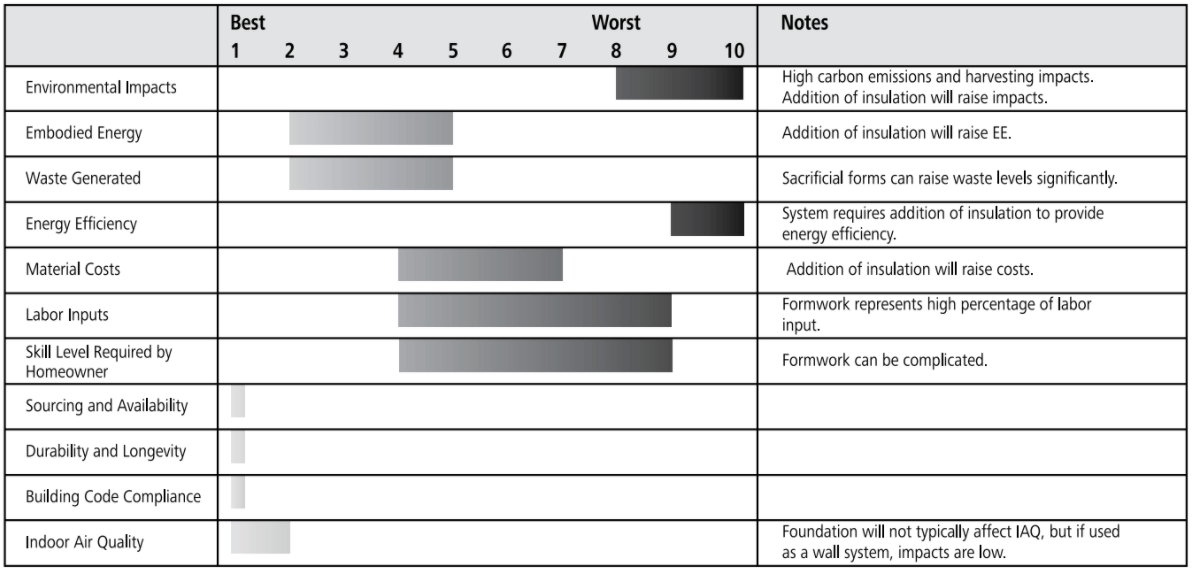
The ratings chart shows comparative performance in each criteria category. Click on the tabs below for detailed analysis of each criteria.
- HOW THE SYSTEM WORKS
- ENVIRONMENTAL IMPACTS
- WASTE
- EMBODIED CARBON
- ENERGY EFFICIENCY
- MATERIAL COSTS
- LABOUR INPUT
- SKILL LEVEL REQUIRED
- SOURCING & AVAILABILITY
- DURABILITY
- CODE COMPLIANCE
- INDOOR AIR QUALITY
- RESOURCES
- FUTURE DEVELOPMENT
Poured concrete Systems
Concrete has many ideal characteristics for use in buildings. It is durable, strong and can be poured as a liquid into any container where it will set. The raw materials are abundant and widespread. If it weren’t for the very high environmental impacts in terms of energy input and carbon output, concrete would be ideal.
Concrete is being included in this book because there are foundations that use reasonable and responsible amounts of concrete to achieve results that are consistent with a sustainable approach to building. To make piers or a perimeter beam, concrete usage and its attendant environmental impacts can be minimized in comparison to conventional usage.
Piers
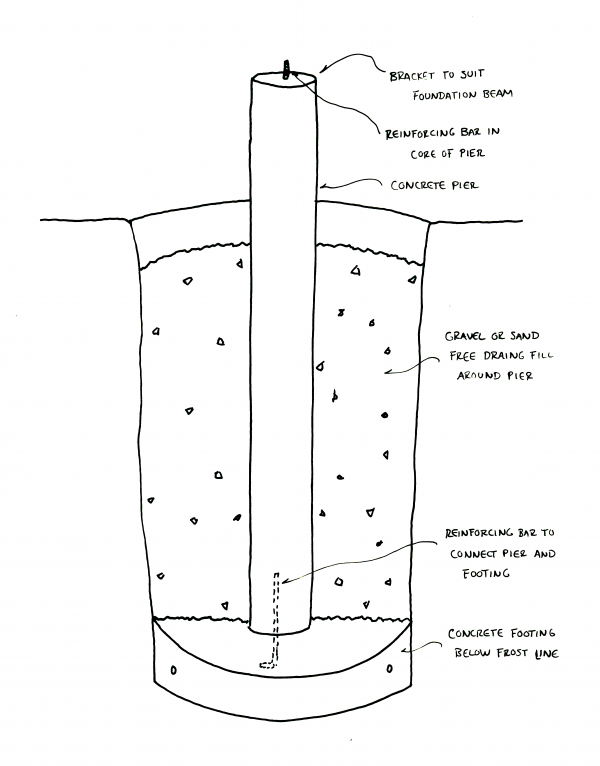 A tubular formwork is placed into the excavated soil, backfilled, and then filled with wet concrete. While the concrete is still wet, an appropriate bracket is placed at the top of the pier to make a connection with the foundation beam.
A tubular formwork is placed into the excavated soil, backfilled, and then filled with wet concrete. While the concrete is still wet, an appropriate bracket is placed at the top of the pier to make a connection with the foundation beam.
Formwork for concrete piers comes in several varieties. Cardboard-based tubes are the most popular. These are installed on top of a previously formed footing at the base of the excavat
ion, or can be attached to plastic forms that create a wide footing and allow the pier and footing to be poured at the same time. Plastic footing cones are also cast with footing and pier as one unit and are typically made of rec
ycled plastic. Fabric forms are another option. These use the tensile strength of woven fabric (material varies by manufacturer) to create tubular forms that are placed, braced and then “inflated” with concrete. They offer the advantage of less material use and lower shipping and handling costs because they can be rolled tightly as opposed to being handled as large tubes.
Most concrete piers are reinforced with rebar in the center of the pour. A pair of bars crossed in the footing and a single bar in the center of the pier is typical.
Perimeter beams
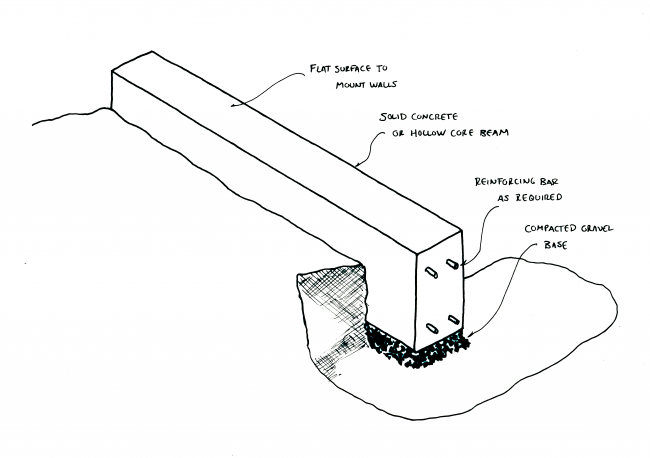
A perimeter beam is a grade-based foundation in which a structural beam is cast from concrete to match the width of the walls above.
For narrow wall systems, it may be necessary to use a footing that is wider than the wall above. For thick wall systems, it is possible to cast the perimeter beam as two narrower beams or to displace concrete in the center of the beam using hollow builder’s tubes or other means of creating a void. The perimeter beam will require some amount of rebar reinforcement as specified by codes or a structural engineer.
As a grade-based foundation, perimeter beams will require some means of protection against frost issues in colder climates. This can be achieved using a rubble trench (*see below) below the perimeter beam that is deeper than the frost line, or by employing an insulated frost skirt around the foundation. A frost skirt creates a shallow, frost-protected foundation (SFPF) and is a widely accepted means of preventing frost from penetrating into soil under a foundation without excavating below the frost line.
Environmental Impact Rating
Harvesting — Moderate to High
Limestone and aggregate mechanically extracted from quarries and can have moderate to high impacts on habitat destruction and ground and surface water contamination and flow.
Steel for reinforcement is a high-impact resource to extract.
Manufacturing — High
The creation of portland cement is high intensity, with limestone being heated in kilns to very high sustained temperatures. Fuels used include natural gas, oil, coal and landfill waste, in large quantities, with impacts including significant air pollution and very significant greenhouse gas emissions due to CO2 being driven out of the stone.
Steel for reinforcement is a very high-impact material to manufacture.
Transportation — Low to High
Sample pier foundation uses 3,336 – 6,312 kg of concrete:
5 – 9.5 MJ per km by 15 ton truck
3.14 – 5.93 MJ per km by 35 ton truck
Sample grade beam foundation uses 5,760 – 15,528 kg of concrete:
8.64 – 23.3 MJ per km by 15 ton truck
5.4 – 14.6 MJ per km by 35 ton truck
Cement and aggregate are heavy, high-volume materials and impacts will rise proportionally with distance traveled.
Installation — Negligible to Moderate
If formwork is sacrificial, impacts can be significant.
Waste: Low
Biodegradable/Compostable — Extra concrete is often broken up and left in the environment. To minimize leftover concrete waste, specify the use of a site-mix truck that adds water to dry ingredients in the spout. This ensures that only the amount needed is mixed, as opposed to ready-mix trucks that add water at the batching plant and must dump all leftover material on-site.
Recyclable — Metal reinforcing bar.
Landfill — Cement bags (if site mixing).
Wooden formwork is sometimes treated as waste, but can usually be re-used or recycled into the building.
Chart of Embodied energy & carbon
Concrete Piers:
concrete Perimeter Beam:
Energy Efficiency:
Concrete Piers: N/a
Concrete piers are typically outside the building enclosure. As such, they don’t have a direct impact on energy efficiency.
Piers are often used to build raised floor decks, in which the floor of the building is elevated above grade and the bottom side of the floor system is exposed to the air. When decoupled from the ground, the underside of a floor system is exposed to greater fluctuations in temperature in cold climates and an insulation strategy must be chosen to deal with this exposure. In such cases, the floor insulation should be at least as thick as the walls, and the same attention must be paid to avoiding thermal bridging and air infiltration or leakage.
Concrete Perimeter Beam: Very low
A concrete perimeter beam foundation has little thermal resistance. In areas where an insulated foundation is important, a strategy to add insulation to the inside and/or outside edge of a concrete foundation will be important. With a proper insulation strategy in place, a concrete foundation can be part of an energy-efficient building.
Material costs:
concrete Piers: Low
concrete Perimeter Beam: Moderate
The popularity of concrete as a building material has a good deal to do with its relatively low cost. However, as energy prices rise, so does the price of concrete, which has gone up an average of 6–12 percent annually since the mid-1990s. This trend is unlikely to change and the rising cost of concrete foundations is one of the key reasons for rising residential housing costs.
Builders should be sure to include the cost of formwork into the foundation price. In some cases, wooden formwork can be stripped from the foundation and reused elsewhere in the building. Pier formwork is always single-use.
Labour Input:
concrete Piers: Low to moderate
concrete Perimeter Beam: moderate to high
Concrete is a form-based building system, and the labor input required is directly related to the type and complexity of the formwork being used.
In the case of perimeter beams, the formwork is likely to be site-built from lumber and plywood and requires carpentry skills to create strong, accurate forms. The more complicated the shape of the building, the more labor will be expended on creating forms.
Piers will not typically require as much labor. If separate footings are being formed and poured prior to setting the piers there will be more labor involved than using all-in-one pier forms with a footing included.
Mixing concrete on site involves considerable labor. Heavy ingredients must be lifted or shoveled into a mixer, poured into a wheelbarrow and delivered to the forms.
Skill level required for homeowners: easy to difficult
A basic perimeter beam foundation requires adequate, accurate formwork and simple screeding and troweling skills to finish the top surface. Creating accurate formwork requires an ability to read plans and translate the drawings into a formwork that will place the concrete in the right position. The biggest mistake made by inexperienced form builders is underestimating the force that will be applied to the forms by wet concrete. Forms must be extremely well braced, cross-tied with wires and staked to the ground in order not to distort when filled.
Concrete foundations typically require some arrangement of metal rebar reinforcement, and cutting, bending and tying the bar is another skill set to learn.
While many new builders can and do form and pour their own concrete foundations, it’s no fluke that most professional contractors hire out concrete work to experienced crews. Experienced concrete contractors employ a great many tricks and techniques. The more concrete being poured, the more valuable that experience.
Sourcing & availability: Easy
Most populated regions will have concrete batching plants within a short radius of any building site, and the batchers should be able to create any mix required for a residential project.
Substitute binders like fly ash or blast furnace slag are becoming more widely available. Since these materials cost less than virgin portland cement, many batching plants use a portion of these binders in their mixes to keep costs down. There is typically a hesitation from batchers to supply mixes with very high percentages of alternative binders, but if local code officials and/or structural engineers will allow the use of higher than normal quantities of fly ash or slag, the batching plant should be willing to deliver such a mix.
Durability: High to Very High
Concrete is a very durable material, capable of performing structurally below and above grade for at least a hundred years.
Code compliance
As a foundation material, concrete is an acceptable solution in all codes. Less conventional approaches, like perimeter beams, may not be formally described but will typically be accepted based on performance evaluation or the approval of a structural engineer. Codes will typically specify concrete strength and the quantity of rebar reinforcement required.
Indoor air quality: N/a
Concrete perimeter beams and piers will have little direct impact on indoor air quality. By keeping the floors and walls of the building dry they can help to prevent other IAQ issues.
Resources for further research
Fine, Homebuilding (COR). Foundations and Concrete Work: Revised and Updated. N.p.: Ingram, 2012. Print.
Arnold, Rick. Working with Concrete. Newtown, CT: Taunton, 2003. Print.
Kelsey, John. Masonry: The DIY Guide to Working with Concrete, Brick, Block, and Stone. East Petersburg: Fox Chapel, 2012. Print.
Future development
A great deal of research is being applied to making “greener” concrete. Effort has been made to optimize regular portland cement by increasing the limestone content and crushing the limestone and clinker to a smaller size, producing a “particle packing effect” that restores strength usually lost with higher limestone content.
Developments in the use of recycled binders like fly ash and slag are an improvement the industry is starting to adopt more widely. The science for replacing portland cement with these binders is well developed, but industry uptake of the materials has been slow. Cost has been one of the main factors driving the industry toward the use of alternative binders. It must be kept in mind, however, that the existing alternative binders are by-products of industrial processes that are just as energy-intensive and polluting as cement production. Making use of these by-products offsets the need to make virgin cement, but it does not mean that the alternative binders aren’t still consuming large amounts of energy and producing large amounts of pollutants.
The use of recycled aggregate (often crushed concrete from demolitions) is a growing way to offset some of the environmental impacts of concrete. As aggregate represents the majority of the volume of concrete, reducing the amount of virgin quarried material is a very worthy goal. In urban areas, the demand for aggregate quarries results in severe environmental degradation and the destruction of habitat in areas adjacent to cities. Reducing the need for new aggregate would have very positive impacts. However, aggregate does not represent a high proportion of the embodied energy or carbon output of concrete. Recycling of old concrete into aggregate for new concrete is not widespread, but as the cost of quarrying virgin aggregate rises along with the costs of disposing of old concrete, it is likely to find more market share.
Efforts are being made to find new ways to make concrete, but most are in early, experimental phases. A process for capturing CO2 from industrial chimneys and injecting it into ready-mix concrete is showing promise, by reducing the amount of portland cement required. This method is currently reaching the market.
Another process using carbon-rich fume gases from natural gas-fired power plants in combination with seawater is showing some promise in creating calcium carbonate cement that could offset portland cement production. The process can also be used to create a calcium carbonate aggregate to replace quarried aggregate, which has a greater volume in concrete. By sequestering carbon from fossil fuel burning, this material has great environmental potential in either form.
Work is being undertaken at labs around the world to find “green” concrete. As the most widely used building material on the planet, the rewards for finding an environmentally friendly version are significant. There is likely to be a number of innovative, “greener” concretes introduced in the coming years. It remains to be seen whether or not this useful but environmentally destructive material can be significantly improved or if the improvements will only be minimal.
Tips for a successful poured concrete foundation
1. Use the highest percentage of portland cement replacement possible for the given application. Blast furnace slag and fly ash are commonly available and can displace a high percentage of virgin cement content, lowering the environmental impact of concrete use.
2. Do not over-build. There is a tendency with concrete design to use more than is structurally necessary. Ensure that the design meets the structural needs with enough concrete and rebar without adding more “just for good measure.”
3. Discuss measures for displacing concrete with a structural engineer. Creating voids is one strategy; adding stone or chunks of old concrete is another. Both are feasible in many applications.
4. Consider the formwork strategy that will be used from an environmental point of view. Single-use forms or those that have a reasonable chance of being ruined will add to the environmental cost of the foundation.
5. Be sure to specify the correct concrete mix. It is important to know the proper strength rating (usually expressed as an MPa or PSI figure) and the need for special admixtures (air entraining, high early strength, etc) when ordering concrete. Suitable concrete mixes may be specified in building codes or determined by a structural engineer. Local concrete batching plants can also supply useful information about mixes.
6. Mixing your own concrete on-site may not be cheaper or more environmentally sound than ordering ready-mix to be delivered. All the materials will still need to be delivered to your site, so the transportation impacts are the same. If you are using a small gas-powered mixer, chances are the emissions are worse than the larger machinery used at a batching plant. Hand-mixed concrete must be produced quickly enough to suffice for larger monolithic pours like a perimeter beam.
